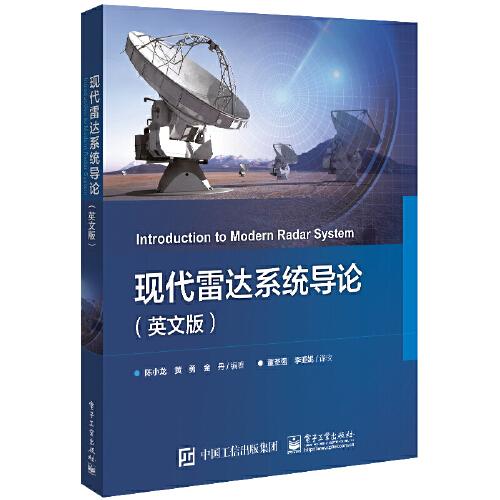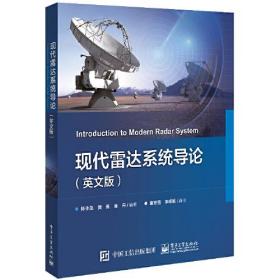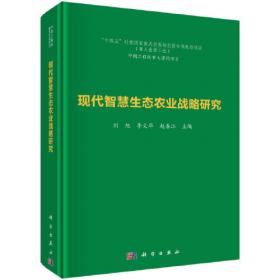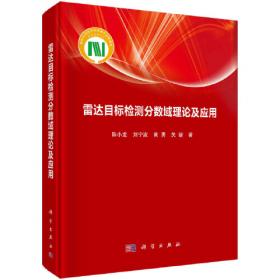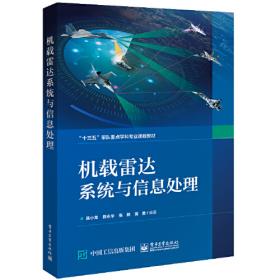现代雷达系统导论(英文版)
出版时间:
2021-08
版次:
1
ISBN:
9787121357770
定价:
69.00
装帧:
其他
开本:
16开
纸张:
胶版纸
页数:
268页
4人买过
-
本书系统地论述了现代雷达的构成、功能、信号和数据处理及应用,内容包括雷达的基本原理、功能、系统组成和性能指标,雷达天线,雷达发射机,雷达接收机,雷达显示和回波,雷达测量,雷达检测距离,雷达目标检测和跟踪,相干雷达信号处理,电子战术语与概念,雷达新技术和新体制等。全书内容全面,论述简明,由浅入深,注重基本原理与实际应用的联系。本书可作为信息与通信工程专业或雷达专业高年级本科生的课外辅导用书,也可作为雷达外训任务的教材,还可作为科技工作者和工程技术人员的参考书籍。 陈小龙,山东烟台人,长期从事雷达原理及弱小目标检测等方面的教学与科研工作。主讲“机载雷达技术”“雷达信号理论”“现代雷达原理”(英文)等课程。发表论文90余篇,授权发明专利20余项。主编教材2部,国家科技出版基金资助专著1部。获省部级奖励4项。中国科协青托、中国电子学会优秀科技工作者。《雷达学报》、《太赫兹科学与电子信息学报》编委。 Contents
Chapter 1 An Introduction to Radar 1
1.1 Fundamental Elements of Radar 2
1.1.1 The Radar Concept 2
1.1.2 Types of Radar 5
1.1.3 Radar Medium 9
1.2 A Brief History of the Evolution of Radar 9
1.2.1 Early Experiments 9
1.2.2 First Military Radars 10
1.3 Functions Performed by Radar 12
1.3.1 Overall System Considerations 12
1.3.2 Basic Radar Functions 14
1.4 Radar Frequency 16
1.4.1 Radar Frequency Division 16
1.4.2 Influence of Frequency on Radar Performance 19
1.5 Some Definitions and Other Details 22
1.5.1 Types of Radar Targets 22
1.5.2 Target Fluctuation Models 23
1.5.3 Noise, Signal-to-Noise Ratio, and Detection 24
Chapter 2 Radar Antenna 27
2.1 Distribution of Radiated Energy in Angle 29
2.2 Types of Radar Antennas 34
2.2.1 Yagi Antennas 34
2.2.2 Reflector Antennas 36
2.2.3 Phased Array Antennas 40
2.3 Characteristics of the Radiation Pattern 45
2.4 Phase Scanning 51
Summary 55
Chapter 3 Radar Transmitter 57
3.1 Requirements for Transmitters 57
3.2 Summary of Radar RF Power Sources 58
3.2.1 Oscillator 61
3.2.2 Tube Amplifiers 63
3.2.3 Solid-State RF Power Sources 66
3.3 Two Basic Transmitter Configurations 68
3.3.1 Self-excited Oscillator 68
3.3.2 Power Oscillator 68
3.3.3 The Pulse Modulator 70
3.4 Pulsed Waveform 72
3.5 Coherent Radar 83
3.5.1 Concept of Coherence 83
3.5.2 Fully Coherent Radar 84
3.5.3 Solid-State Amplifier 87
Summary 88
Chapter 4 Radar Receiver 90
4.1 Summary of Receiver Types 91
4.1.1 Crystal Video Receiver 92
4.1.2 Homodyne Receivers 93
4.1.3 Superheterodyne Receivers 94
4.2 Major Receiver Functions 99
4.2.1 Receiver Protection 99
4.2.2 RF Preselection 100
4.2.3 Frequency Downconversion and Mixers 101
4.2.4 Selection of LO and IF Frequencies 102
4.3 Electrical Background Noise 103
4.4 Receiver Dynamic Range 108
4.4.1 Sensitivity Time Control (STC) 110
4.4.2 Gain Control 111
Summary 112
Chapter 5 Radar Display and Returns 113
5.1 Radar Displays 114
5.2 Radar Clutter 118
5.2.1 Introduction to Radar Clutter 118
5.2.2 General Dependencies of Surface Clutter 121
5.2.3 Sea Clutter 122
Chapter 6 Radar Measurements 127
6.1 Range Measurements 128
6.1.1 Pulse Ranging Method 128
6.1.2 Minimum Range 128
6.1.3 Maximum Range 129
6.1.4 Range Resolution 130
6.1.5 Pulse Compression 132
6.2 Direction Measurements 136
6.2.1 Lobing Angle Measurement 137
6.2.2 Monopulse Angle Measurement 138
6.3 Velocity Measurements 143
6.3.1 Doppler Effect 143
6.3.2 Doppler Shift 144
6.3.3 Unambiguous Doppler Shift Measurement 147
Summary 148
Chapter 7 The Radar Detection Range 150
7.1 What Determines Detection Range 151
7.2 Radar Range Equation 154
7.2.1 Power Density at a Distance R 154
7.2.2 Received Power from a Target 155
7.2.3 Signal-to-Noise Ratio and the Radar Range Equation 157
7.2.4 Summary of Losses 158
7.2.5 Solving For Other Variables 159
7.2.6 Decibel Form of the Radar Range Equation 159
7.2.7 Radar Line of Sight (RLOS) 161
7.2.8 Radar Reflections from Flat Ground 162
7.2.9 The Radar Equation in Practice 163
7.3 What the Range Equation Tells Us 165
7.4 Surface Clutter Radar Equation 169
Summary 171
Chapter 8 Fundamental of Radar Detection and Tracking 173
8.1 Detection Process 173
8.2 Integration and Its Leverage on Detection Range 177
8.2.1 Integration Experiment 177
8.2.2 Multiple-Pulse Effects on Radar Equation 181
8.3 Parameters of Radar Detection 183
8.3.1 Detection Probability 183
8.3.2 False-Alarm Rate 184
8.3.3 Detection Threshold 185
8.3.4 Signal-to-Noise Ratio 187
8.4 Constant False Alarm Rate Detector 189
8.4.1 Basic CFAR Architecture 190
8.4.2 Cell Averaging CFAR 192
8.5 Tracking with Radar 195
8.5.1 Types of Tracking 195
8.5.2 Radar Range Tracking 197
8.6 Radar Signal Management 201
Summary 203
Chapter 9 Coherent Radar Signal Processing 204
9.1 Pulsed Radar Doppler Data Acquisition and Characteristics 206
9.2 Moving Target Indication (MTI) 208
9.2.1 Basic Principle 208
9.2.2 Pulse Cancellers 210
9.2.3 Blind Speeds 212
9.2.4 Merits and Limitations 213
9.3 Pulse-Doppler Processing 215
9.3.1 Basic Principle 215
9.3.2 Doppler Filter Bank 217
9.3.3 Metrics for Pulse-Doppler Detection of Moving Targets 219
9.3.4 The Moving Target Detector (MTD) 221
Summary 225
Chapter 10 Electronic Warfare Terms and Concepts 226
10.1 EW Definition 226
10.2 EW Subfields 226
10.3 Electronic Warfare Support 227
10.4 Electronic Attack 233
10.5 Electronic Protection 240
Summary 242
Chapter 11 New Technology and System of Radar 243
11.1 Low Probability of Intercept (LPI) Radar 243
11.2 Multifunction Rotating Electronically Scanned Radars 245
11.3 Ultra Wide-Band (UWB) Radar 246
11.4 Noise Radar Technology 247
11.5 Multi-Input Multi-Output (MIMO) Radar 248
11.6 Synthetic Aperture Radar (SAR) 249
11.7 Air-Defense Radars 251
11.8 Ground Penetrating Radar (GPR) 252
Reference 256
-
内容简介:
本书系统地论述了现代雷达的构成、功能、信号和数据处理及应用,内容包括雷达的基本原理、功能、系统组成和性能指标,雷达天线,雷达发射机,雷达接收机,雷达显示和回波,雷达测量,雷达检测距离,雷达目标检测和跟踪,相干雷达信号处理,电子战术语与概念,雷达新技术和新体制等。全书内容全面,论述简明,由浅入深,注重基本原理与实际应用的联系。本书可作为信息与通信工程专业或雷达专业高年级本科生的课外辅导用书,也可作为雷达外训任务的教材,还可作为科技工作者和工程技术人员的参考书籍。
-
作者简介:
陈小龙,山东烟台人,长期从事雷达原理及弱小目标检测等方面的教学与科研工作。主讲“机载雷达技术”“雷达信号理论”“现代雷达原理”(英文)等课程。发表论文90余篇,授权发明专利20余项。主编教材2部,国家科技出版基金资助专著1部。获省部级奖励4项。中国科协青托、中国电子学会优秀科技工作者。《雷达学报》、《太赫兹科学与电子信息学报》编委。
-
目录:
Contents
Chapter 1 An Introduction to Radar 1
1.1 Fundamental Elements of Radar 2
1.1.1 The Radar Concept 2
1.1.2 Types of Radar 5
1.1.3 Radar Medium 9
1.2 A Brief History of the Evolution of Radar 9
1.2.1 Early Experiments 9
1.2.2 First Military Radars 10
1.3 Functions Performed by Radar 12
1.3.1 Overall System Considerations 12
1.3.2 Basic Radar Functions 14
1.4 Radar Frequency 16
1.4.1 Radar Frequency Division 16
1.4.2 Influence of Frequency on Radar Performance 19
1.5 Some Definitions and Other Details 22
1.5.1 Types of Radar Targets 22
1.5.2 Target Fluctuation Models 23
1.5.3 Noise, Signal-to-Noise Ratio, and Detection 24
Chapter 2 Radar Antenna 27
2.1 Distribution of Radiated Energy in Angle 29
2.2 Types of Radar Antennas 34
2.2.1 Yagi Antennas 34
2.2.2 Reflector Antennas 36
2.2.3 Phased Array Antennas 40
2.3 Characteristics of the Radiation Pattern 45
2.4 Phase Scanning 51
Summary 55
Chapter 3 Radar Transmitter 57
3.1 Requirements for Transmitters 57
3.2 Summary of Radar RF Power Sources 58
3.2.1 Oscillator 61
3.2.2 Tube Amplifiers 63
3.2.3 Solid-State RF Power Sources 66
3.3 Two Basic Transmitter Configurations 68
3.3.1 Self-excited Oscillator 68
3.3.2 Power Oscillator 68
3.3.3 The Pulse Modulator 70
3.4 Pulsed Waveform 72
3.5 Coherent Radar 83
3.5.1 Concept of Coherence 83
3.5.2 Fully Coherent Radar 84
3.5.3 Solid-State Amplifier 87
Summary 88
Chapter 4 Radar Receiver 90
4.1 Summary of Receiver Types 91
4.1.1 Crystal Video Receiver 92
4.1.2 Homodyne Receivers 93
4.1.3 Superheterodyne Receivers 94
4.2 Major Receiver Functions 99
4.2.1 Receiver Protection 99
4.2.2 RF Preselection 100
4.2.3 Frequency Downconversion and Mixers 101
4.2.4 Selection of LO and IF Frequencies 102
4.3 Electrical Background Noise 103
4.4 Receiver Dynamic Range 108
4.4.1 Sensitivity Time Control (STC) 110
4.4.2 Gain Control 111
Summary 112
Chapter 5 Radar Display and Returns 113
5.1 Radar Displays 114
5.2 Radar Clutter 118
5.2.1 Introduction to Radar Clutter 118
5.2.2 General Dependencies of Surface Clutter 121
5.2.3 Sea Clutter 122
Chapter 6 Radar Measurements 127
6.1 Range Measurements 128
6.1.1 Pulse Ranging Method 128
6.1.2 Minimum Range 128
6.1.3 Maximum Range 129
6.1.4 Range Resolution 130
6.1.5 Pulse Compression 132
6.2 Direction Measurements 136
6.2.1 Lobing Angle Measurement 137
6.2.2 Monopulse Angle Measurement 138
6.3 Velocity Measurements 143
6.3.1 Doppler Effect 143
6.3.2 Doppler Shift 144
6.3.3 Unambiguous Doppler Shift Measurement 147
Summary 148
Chapter 7 The Radar Detection Range 150
7.1 What Determines Detection Range 151
7.2 Radar Range Equation 154
7.2.1 Power Density at a Distance R 154
7.2.2 Received Power from a Target 155
7.2.3 Signal-to-Noise Ratio and the Radar Range Equation 157
7.2.4 Summary of Losses 158
7.2.5 Solving For Other Variables 159
7.2.6 Decibel Form of the Radar Range Equation 159
7.2.7 Radar Line of Sight (RLOS) 161
7.2.8 Radar Reflections from Flat Ground 162
7.2.9 The Radar Equation in Practice 163
7.3 What the Range Equation Tells Us 165
7.4 Surface Clutter Radar Equation 169
Summary 171
Chapter 8 Fundamental of Radar Detection and Tracking 173
8.1 Detection Process 173
8.2 Integration and Its Leverage on Detection Range 177
8.2.1 Integration Experiment 177
8.2.2 Multiple-Pulse Effects on Radar Equation 181
8.3 Parameters of Radar Detection 183
8.3.1 Detection Probability 183
8.3.2 False-Alarm Rate 184
8.3.3 Detection Threshold 185
8.3.4 Signal-to-Noise Ratio 187
8.4 Constant False Alarm Rate Detector 189
8.4.1 Basic CFAR Architecture 190
8.4.2 Cell Averaging CFAR 192
8.5 Tracking with Radar 195
8.5.1 Types of Tracking 195
8.5.2 Radar Range Tracking 197
8.6 Radar Signal Management 201
Summary 203
Chapter 9 Coherent Radar Signal Processing 204
9.1 Pulsed Radar Doppler Data Acquisition and Characteristics 206
9.2 Moving Target Indication (MTI) 208
9.2.1 Basic Principle 208
9.2.2 Pulse Cancellers 210
9.2.3 Blind Speeds 212
9.2.4 Merits and Limitations 213
9.3 Pulse-Doppler Processing 215
9.3.1 Basic Principle 215
9.3.2 Doppler Filter Bank 217
9.3.3 Metrics for Pulse-Doppler Detection of Moving Targets 219
9.3.4 The Moving Target Detector (MTD) 221
Summary 225
Chapter 10 Electronic Warfare Terms and Concepts 226
10.1 EW Definition 226
10.2 EW Subfields 226
10.3 Electronic Warfare Support 227
10.4 Electronic Attack 233
10.5 Electronic Protection 240
Summary 242
Chapter 11 New Technology and System of Radar 243
11.1 Low Probability of Intercept (LPI) Radar 243
11.2 Multifunction Rotating Electronically Scanned Radars 245
11.3 Ultra Wide-Band (UWB) Radar 246
11.4 Noise Radar Technology 247
11.5 Multi-Input Multi-Output (MIMO) Radar 248
11.6 Synthetic Aperture Radar (SAR) 249
11.7 Air-Defense Radars 251
11.8 Ground Penetrating Radar (GPR) 252
Reference 256
查看详情
-
全新
广东省广州市
平均发货7小时
成功完成率94.29%
-
全新
河北省保定市
平均发货29小时
成功完成率91.01%
-
全新
河北省保定市
平均发货30小时
成功完成率88.52%
-
全新
河北省保定市
平均发货27小时
成功完成率86.66%
-
全新
河北省保定市
平均发货29小时
成功完成率91.01%
-
全新
河北省保定市
平均发货28小时
成功完成率89.21%
-
全新
河北省保定市
平均发货28小时
成功完成率89.21%
-
全新
河北省保定市
平均发货28小时
成功完成率89.21%
-
全新
河北省保定市
平均发货18小时
成功完成率91.93%
-
九品
北京市昌平区
平均发货23小时
成功完成率88.73%
-
全新
山东省泰安市
平均发货25小时
成功完成率90.99%
-
全新
四川省成都市
平均发货52小时
成功完成率85.22%
-
现代雷达系统导论(英文版)
图片是系统识别图,仅供参考,以书号或书名为准 如有套装书(或图片与书名不符),价格异常,可能是单本书的价
全新
河北省保定市
平均发货11小时
成功完成率92.47%
-
全新
浙江省嘉兴市
平均发货13小时
成功完成率94.91%
-
全新
北京市朝阳区
平均发货12小时
成功完成率96.84%
-
全新
河北省保定市
平均发货28小时
成功完成率90.45%
-
全新
山东省泰安市
平均发货7小时
成功完成率94.16%
-
全新
河北省保定市
平均发货29小时
成功完成率89.09%
-
全新
广东省广州市
平均发货17小时
成功完成率94.75%
-
全新
广东省广州市
平均发货17小时
成功完成率93.26%
-
全新
广东省广州市
平均发货16小时
成功完成率92.16%
-
全新
河北省保定市
平均发货28小时
成功完成率85.14%
-
全新
北京市通州区
平均发货11小时
成功完成率96.19%
-
全新
北京市通州区
平均发货10小时
成功完成率91.6%
-
全新
河北省保定市
平均发货28小时
成功完成率89.22%
-
全新
广东省广州市
平均发货10小时
成功完成率94.98%
-
九五品
北京市通州区
平均发货32小时
成功完成率82.41%
-
八五品
北京市通州区
平均发货13小时
成功完成率94.08%
-
全新
北京市房山区
平均发货35小时
成功完成率83.14%
-
全新
河北省保定市
平均发货21小时
成功完成率87.79%
-
全新
北京市通州区
平均发货9小时
成功完成率89.04%
-
全新
北京市丰台区
平均发货7小时
成功完成率93.09%
-
全新
北京市海淀区
平均发货8小时
成功完成率94.36%
-
全新
北京市朝阳区
平均发货16小时
成功完成率78.12%
-
 2
2
全新
河北省保定市
平均发货27小时
成功完成率89.66%
-
全新
天津市津南区
平均发货13小时
成功完成率85.34%
-
全新
浙江省嘉兴市
平均发货10小时
成功完成率93.16%
-
现代雷达系统导论(英文版)
本店所有图书均为正版一手库存书,无笔记,未翻阅。电脑自动采集上传,如果商品名称和图片不符时(注:有很多单本,系统会匹配套装图片,下单请提前咨询)本店以商品名称和书号为准,配货发货只核对书号和商品名称,谢谢
全新
河北省保定市
平均发货8小时
成功完成率83.87%
-
全新
河北省保定市
平均发货31小时
成功完成率84.05%
-
八五品
河北省廊坊市
平均发货13小时
成功完成率84.38%
-
全新
广东省广州市
平均发货9小时
成功完成率88.48%
-
全新
河北省保定市
平均发货7小时
成功完成率84.62%
-
全新
河北省廊坊市
平均发货17小时
成功完成率83.91%
-
九品
北京市海淀区
平均发货24小时
成功完成率83.36%
-
全新
河北省沧州市
平均发货13小时
成功完成率78.92%
-
全新
北京市房山区
平均发货12小时
成功完成率73.71%
-
全新
河北省保定市
平均发货25小时
成功完成率68.22%
-
全新
河北省保定市
平均发货12小时
成功完成率67.06%
-
全新
河北省保定市
平均发货26小时
成功完成率84.29%
-
九品
北京市昌平区
平均发货17小时
成功完成率90.48%

 占位居中
占位居中

